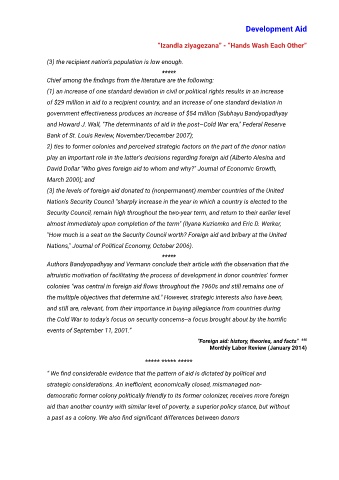Page 392 - Volume 2_CHANGES_merged_with links
P. 392
Development Aid
“Izandla ziyagezana” - “Hands Wash Each Other”
(3) the recipient nation's population is low enough.
*****
Chief among the findings from the literature are the following:
(1) an increase of one standard deviation in civil or political rights results in an increase
of $29 million in aid to a recipient country, and an increase of one standard deviation in
government effectiveness produces an increase of $54 million (Subhayu Bandyopadhyay
and Howard J. Wall, "The determinants of aid in the post–Cold War era," Federal Reserve
Bank of St. Louis Review, November/December 2007);
2) ties to former colonies and perceived strategic factors on the part of the donor nation
play an important role in the latter's decisions regarding foreign aid (Alberto Alesina and
David Dollar "Who gives foreign aid to whom and why?" Journal of Economic Growth,
March 2000); and
(3) the levels of foreign aid donated to (nonpermanent) member countries of the United
Nation's Security Council "sharply increase in the year in which a country is elected to the
Security Council, remain high throughout the two-year term, and return to their earlier level
almost immediately upon completion of the term" (Ilyana Kuziemko and Eric D. Werker,
"How much is a seat on the Security Council worth? Foreign aid and bribery at the United
Nations," Journal of Political Economy, October 2006).
*****
Authors Bandyopadhyay and Vermann conclude their article with the observation that the
altruistic motivation of facilitating the process of development in donor countries' former
colonies "was central in foreign aid flows throughout the 1960s and still remains one of
the multiple objectives that determine aid." However, strategic interests also have been,
and still are, relevant, from their importance in buying allegiance from countries during
the Cold War to today's focus on security concerns--a focus brought about by the horrific
events of September 11, 2001.”
"Foreign aid: history, theories, and facts" 440
Monthly Labor Review (January 2014)
***** ***** *****
“ We find considerable evidence that the pattern of aid is dictated by political and
strategic considerations. An inefficient, economically closed, mismanaged non-
democratic former colony politically friendly to its former colonizer, receives more foreign
aid than another country with similar level of poverty, a superior policy stance, but without
a past as a colony. We also find significant differences between donors

